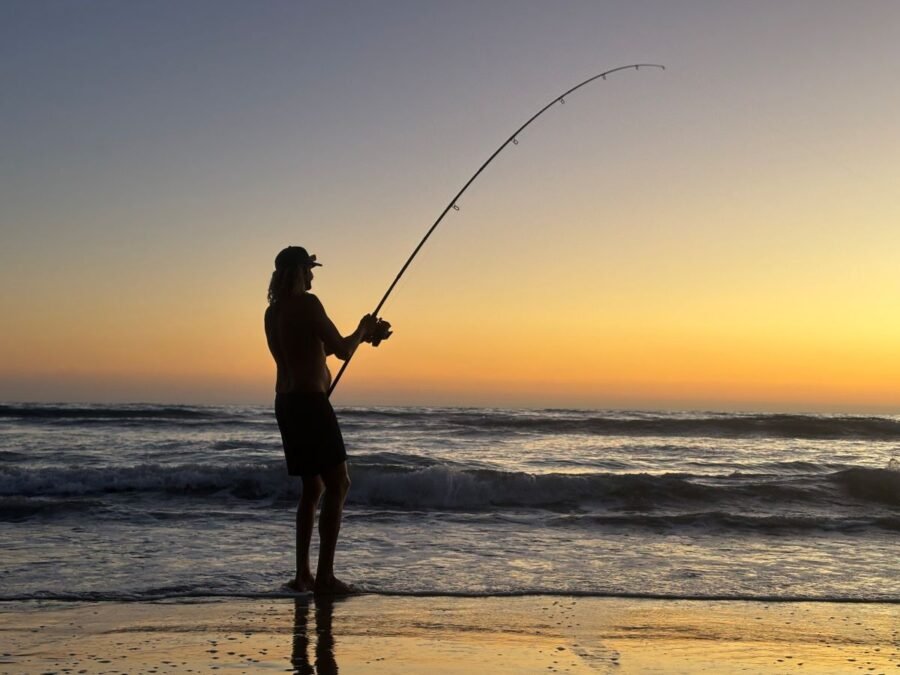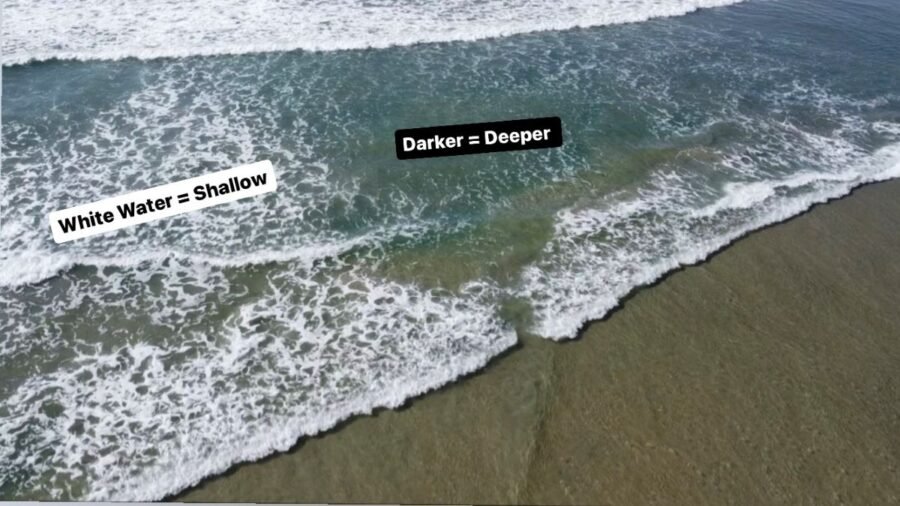How Far to Cast When Surf Fishing

Most people assume that long casts equal more fish and bigger fish, but that’s not usually true. When surf fishing in Southern California, the best bite often happens right in front of you, sometimes in just a few inches of water. Knowing how far to cast when surf fishing depends less on power and more on understanding structure, fish behavior, and timing.
By the end of this article, you’ll know two simple rules to decide how far to cast and how to approach both shallow and deeper structure effectively.
Rule 1: Fish to the Structure
Fish are drawn to structure. That might be a trough, a hole, nearby to a rip current, or a cut where bait and current concentrate. If the structure is twenty feet out, cast twenty feet. If the tide rises and that trough moves out another twenty feet, cast forty. It’s that simple. Always fish to the structure.
Rule 2: Fish to Where the Fish Are
Sometimes you don’t need to cast far at all or cast into the structure. When you can see fish in the shallows (especially corbina, spotfin croaker, and guitarfish) sight casting can be a productive option. You cast only as far as needed to reach the fish without spooking them. These fish can cruise in just inches of water, often feeding on sand crabs along the wash zone.
Fish Activity in the “Skinny” Water
The “skinny” is the shallow zone where waves roll and retreat, exposing wet sand where sand crabs can be found. That’s the buffet line for species like corbina, spotfin croaker, guitarfish, and stingrays.
If you see fish in the shallows, you can “hunt” them with a method called sight fishing or sight casting. Additionally, don’t ever rule out structure that might feel like it’s in too shallow of water. Some of the biggest corbina and spotfin croaker are caught in troughs and holes that are in transitional areas of water that go from 6 inches outside the trough to 1.5-2 feet in the trough.
It’s not uncommon to see fish so close to shore that when a wave recedes, a fish momentarily beaches itself before swimming back out. This is normal feeding behavior in the summer months when the water is warm and sand crabs are everywhere.
When fishing the skinny, distance doesn’t matter, but being stealth does. Stay quiet, move slowly, and focus on accuracy. Your goal is to place your bait naturally in their path, not to bomb a cast on their heads.
On the lure fishing side of things, some of the largest halibut are also caught in structure that is extremely close to shore in sandy pockets between reef/rocks in less than 2-3 feet of water. We won’t be talking much about the lure side of things in this article.
Sight Casting: When to Cast Short and How Short
Sight casting is about precision. When you spot a corbina or croaker cruising, keep a good distance between you and the fish (about 10 to 20 feet) and lead your cast just ahead of its path. Cast as short as the fish is.
If you land your bait too close or make a big splash, the fish is gone. Use a lighter weight or smaller Carolina rig to reduce splash and allow a softer entry into the water. Casting into whitewater can also help mask the sound and vibration of your cast.
To dive deeper on sight casting and how to do it successfully, read the linked article.
When to Fish the Structure and Cast Longer

Sometimes the structure is farther out, especially when you’re fishing a deeper trough, a cut, or a nearshore reef. In these cases, a longer cast helps you reach that prime zone where bait collects and fish patrol.
Structure can include:
- Troughs and holes
- Rip currents and cuts
- Jetties, rock piles, and reef edges
For a detailed look at identifying these features, check out my article on how to read the surf.
For sandy-bottom species like surfperch, croaker, and corbina, your “structure” is usually soft — troughs, cuts, and holes. For halibut or calico bass, you’ll target the sandy pockets near hard structure like rocks or reefs.
At the end of the day, you cast only as far as it takes to reach the structure. That might be 20 feet or 80, depending on the tide and beach conditions.
Conclusion
When it comes to how far to cast when surf fishing, there’s no magic number. It all comes down to these two rules: fish to the structure and fish to where the fish are.
Most of the time, you’ll be surprised by how close the fish really are. Some of the biggest corbina and spotfin croaker I’ve caught were feeding in the skinny water, just feet from shore.
Next time you hit the beach, try a session focused on short, accurate casts. Learn the structure, stay quiet, and let the ocean tell you where the fish want to be. And make sure you’re using the right gear and tackle:
Light Tackle Gear
- Rod: Okuma Celilo (8’6″ MA) or the Okuma SST (8’6″ MA)
- Reel: Penn Battle II or III 4000 series
- Mainline: 15-pound monofilament
- For Bait: Carolina Rig:
- Leader Line: 15-pound fluorocarbon
- Swivels: 15-19mm barrel swivels
- Hooks: size #2 or #4 owner mosquito hooks
- Weights: 1-oz egg weight
- Beads: 8mm fishing beads
Swim Bait Gear
- Rod: Okuma SST-S-902HA – 1/2-2oz | 10-30lb | 9ft | H | MF
- Reel: Penn Spinfisher VI (3500 or 4500)
- Main Line: 30-pound braid
- Leader Line: 30-pound mono
- Lure Options:
Jerk Bait Gear
- Rod: Okuma SST (8’6″ MHA)
- Reel: Penn Battle II or III 4000 series
- Main Line:
- Leader Line: 15-pound fluorocarbon
- Lures: Lucky Craft FM 110 and Shimano WM 115 SP
Shark Gear
- Rod: Fiblink Moonsniper (12 or 13 feet)
- Reel: Penn Battle 8000 (II or III)
- Main Line: 50-pound braid
- Topshot: 100-pound nylon coated mono
- Leaders: Shark Leaders
- Weights: 8-ounce pyramid or 6-ounce sputnik
Does this apply to winter fishing as well?
There are definitely fewer fish in the shallows in the winter. Basically if you see fish feeding in the shallows, fish them. Otherwise fish to wherever the structure is. That always applies in all seasons.
Thanks Nick!
Good advice! I often fall into bad habits of trying to cast as far possible, period. I did this when I started fishing freshwater as well, casting to the middle of lakes instead of cover and structure in the shallows. I will definitely focus on shorter casts the next time I’m on the water.
It’s a tough habit to break. Good luck out there!